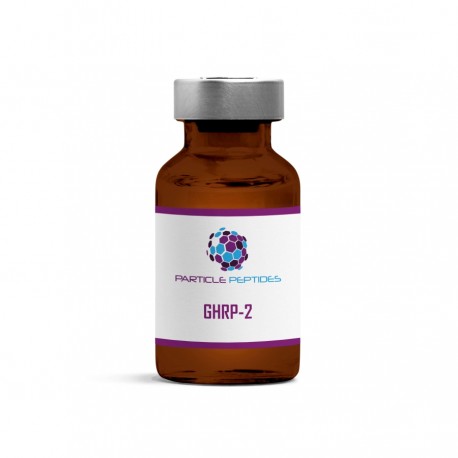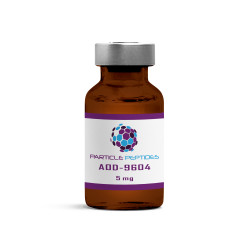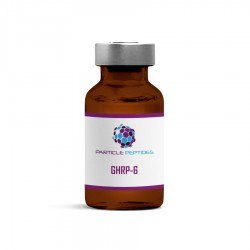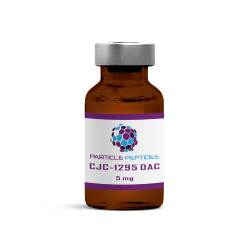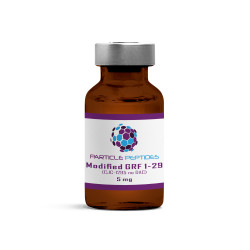Description of GHRP-2
A synthetically produced hexapeptide GHRP-2 is structurally composed of a non-glycosylated polypeptide chain with 6 amino acids in the sequence. It was developed by Kaken Pharmaceutical as a potential compound that significantly increases plasma GH levels when administered acutely. However, it was investigated as a test peptide for treating GH deficiency (GHD) and short stature. As a agonist of ghrelin, orally and sublingually active, it has similar influence demonstrated in research of peripheral administration of GHRP-2, which increased food intake in humans. The effect of this peptide is robust, and the magnitude of the effect of GHRP-2 on food intake (+35%) is comparable to that of ghrelin shown to increase food intake by 28% in healthy subjects and by 31% in cancer patients. It has also similar GH release effects. Except of this, GHRP-2 enhances muscle growth and reduces body fat, strengthens the immune system and improves quality of sleep. Let us show you some evidence and results of particular studies.
[1]
Research Confirmed Effects
1. GHRP-2 and Muscle Development
The effects of GHRP-2 administration and the basis of its regulatory mechanism on growth performance were investigated in yaks with growth retardation caused primarily due to somatotropic axis hormones secretion deficiency. It was found that administration of GHRP-2 can accelerate growth performance in yaks, GH and IGF-1 secretion, and enhance muscle protein deposition by upregulating the protein synthesis pathways in liver and skeletal muscles.
GHRP-2 can also reduce muscle atrophy by activating proteins Atrogin-1 and MuRF1, which control the muscle degradation, and thus, play a pivotal role in muscle atrophy. The study investigated the effect of GHRP-2 on the expressions of these in vivo of rat muscles. As a result it was considered that GHRP-2 directly attenuates Atrogin-1 and MuRF1 mRNA levels through ghrelin receptors in myocytes.
The peptide’s effect on protein deposition increase and protein degradation decrease is essential for its ability to enhance muscle growth and development. Results in swine research indicated that GHRP-2 stimulates GH release and enhances growth performance of swine. The chronic administration increased average daily gain for the entire treatment period by 22.35% and feed efficiency by 20.64% over the saline controls, whereas daily feed intake was not significantly affected.
[2] - [4]
2. GHRP-2 and Appetite Stimulation
Peptide GHRP-2 has shown similar effects in food intake and appetite stimulation with short-term subcutaneous infusions like hormone ghrelin. The experiment in 7 lean healthy men indicated that food intake at the buffet meal was increased by 35.9±10.9 % (range 12 to 95%) with GHRP-2 compared to placebo. Each and every subject responded to the GHRP-2 infusion by increasing their food intake, regardless of the amount of food eaten during the saline control experiment. The total amount of calories eaten was greater with GHRP-2 than with placebo. In addition, no side effects from the infusion were reported. However, similar results were observed also in obese patients in a dose-dependent manner.
[5], [6]
3. GHRP-2 in Cardiovascular System and Heart
The neuroendocrine activities of GHRP-2 and other GHRPs are mediated by specific receptors subtypes that have been identified in the pituitary gland, hypothalamus and various extra-hypothalamic brain regions. In addition, these specific GHRP receptors were also found in different peripheral tissues such as heart, adrenal, ovary, testis, lung and skeletal muscle, with a significantly higher density than in the hypothalamo-pituitary-system. A remarkable specific (125)I-Tyr-Ala-hexarelin binding was observed in the human cardiovascular system where the highest binding levels were detected in ventricles, followed by atria, aorta, coronaries, carotid, endocardium and vena cava. In conclusion, GHRPs possess extra neuroendocrine biological activity and show direct GH-independent cardiotropic effects.
Hexarelin, an synthetic analogue of GHRP-2, featured protecting activity against postischemic ventricular dysfunction in hearts from GH-deficient and senescent rats. The results of this study suggested existence of a new hexarelin receptor in the heart, whose role in the regulation of the coronary vascular tone has to be still investigated.
[7], [8]
4. GHRP-2 and Immune System
GHRP-2 seems to have very positive influence on the immune system mostly by promoting thymus functions and supporting T-cells production. GHRP-2 rejuvenates the thymus gland, which plays a crucial role in immune system. By GH-mediated and ghrelin-mediated pathways the peptid rejuvenates thymus gland and boosts the number and diversity of T-cells, and thus restore thymic function in aged and immunocompromised individuals. Thus, GHRP-2 has positive effects on immunity response.
[9]
5. GHRP-2 and Sleep Improvement
GHRP-2 as other growth hormone secretagogues can improve sleep quality. A particular study on similar peptide showed improved sleeping quality of young and old men. In young subjects, high-dose of the peptide treatment resulted in an approximately 50% increase in the duration of stage IV of sleep cycle and in a more than 20% increase in REM sleep as compared to placebo. On the other hand older adults showed nearly 50% increase in REM sleep and a decrease in REM latency. The sleep quality was thus apparently improved.
[10]
6. GHRP-2 Affects Pain Perception
GHRP-2, as a ghrelin receptor agonist, produces antinociceptive effects at the supraspinal level via the opioid receptor in mice. in previous experiments ghrelin induced analgesic effect through an interaction with GHS-R1α and with the central opioid system in the acute pain in mice, and GHRP-2 has similar physiological functions as ghrelin. Intracerebroventricular administration of GHRP-2 produced a concentration- and time-related antinociceptive effect, which could be very good base for developing a new efficient analgesic drug, because GHRP-2 can directly influence the pain perception by activating opioid receptors, and not only heal the tissues by GH release.
[11]
References
- B. Laferrere et al.,„Growth Hormone Releasing Peptide -2 (GHRP-2), like ghrelin, increases food intake in healthy men,“ 2005 Feb; 90(2): 611–614.
- D. Yamamoto et al., “GHRP-2, a GHS-R agonist, directly acts on myocytes to attenuate the dexamethasone-induced expressions of muscle-specific ubiquitin ligases, Atrogin-1 and MuRF1,” Life Sci., vol. 82, no. 9–10, pp. 460–466, Feb. 2008.
- L. T. Phung et al., “The effects of growth hormone-releasing peptide-2 (GHRP-2) on the release of growth hormone and growth performance in swine,” Domest. Anim. Endocrinol., vol. 18, no. 3, pp. 279–291, Apr. 2000.
- B. Laferrère, C. Abraham, C. D. Russell, and C. Y. Bowers, “Growth hormone releasing peptide-2 (GHRP-2), like ghrelin, increases food intake in healthy men,” J. Clin. Endocrinol. Metab., vol. 90, no. 2, pp. 611–614, Feb. 2005.
- B. Laferrère, A. B. Hart, and C. Y. Bowers, “Obese subjects respond to the stimulatory effect of the ghrelin agonist growth hormone-releasing peptide-2 on food intake,” Obes. Silver Spring Md, vol. 14, no. 6, pp. 1056–1063, Jun. 2006.
- G. Muccioli et al., “Growth hormone-releasing peptides and the cardiovascular system,” Ann. Endocrinol., vol. 61, no. 1, pp. 27–31, Feb. 2000.
- V. Bodart et al., “Identification and characterization of a new growth hormone-releasing peptide receptor in the heart,” Circ. Res., vol. 85, no. 9, pp. 796–802, Oct. 1999.
- D. D. Taub, W. J. Murphy, and D. L. Longo, “Rejuvenation of the aging thymus: growth hormone-mediated and ghrelin-mediated signaling pathways,” Curr. Opin. Pharmacol., vol. 10, no. 4, pp. 408–424, Aug. 2010.
- G. Copinschi et al., “Prolonged oral treatment with MK-677, a novel growth hormone secretagogue, improves sleep quality in man,” Neuroendocrinology, vol. 66, no. 4, pp. 278–286, Oct. 1997.
- P. Zeng et al., “Ghrelin receptor agonist, GHRP-2, produces antinociceptive effects at the supraspinal level via the opioid receptor in mice,” Peptides, vol. 55, pp. 103–109, May 2014.
- Moulin, A. , Ryan, J. , Martinez, J. and Fehrentz, J. (2007), Recent Developments in Ghrelin Receptor Ligands. ChemMedChem, 2: 1242-1259.
 Longevity and Anti-aging Research
Longevity and Anti-aging Research
 Weight Loss Research
Weight Loss Research
 Sleep Enhancement Research
Sleep Enhancement Research
 Muscle Growth research
Muscle Growth research
 Healing and Regeneration research
Healing and Regeneration research
